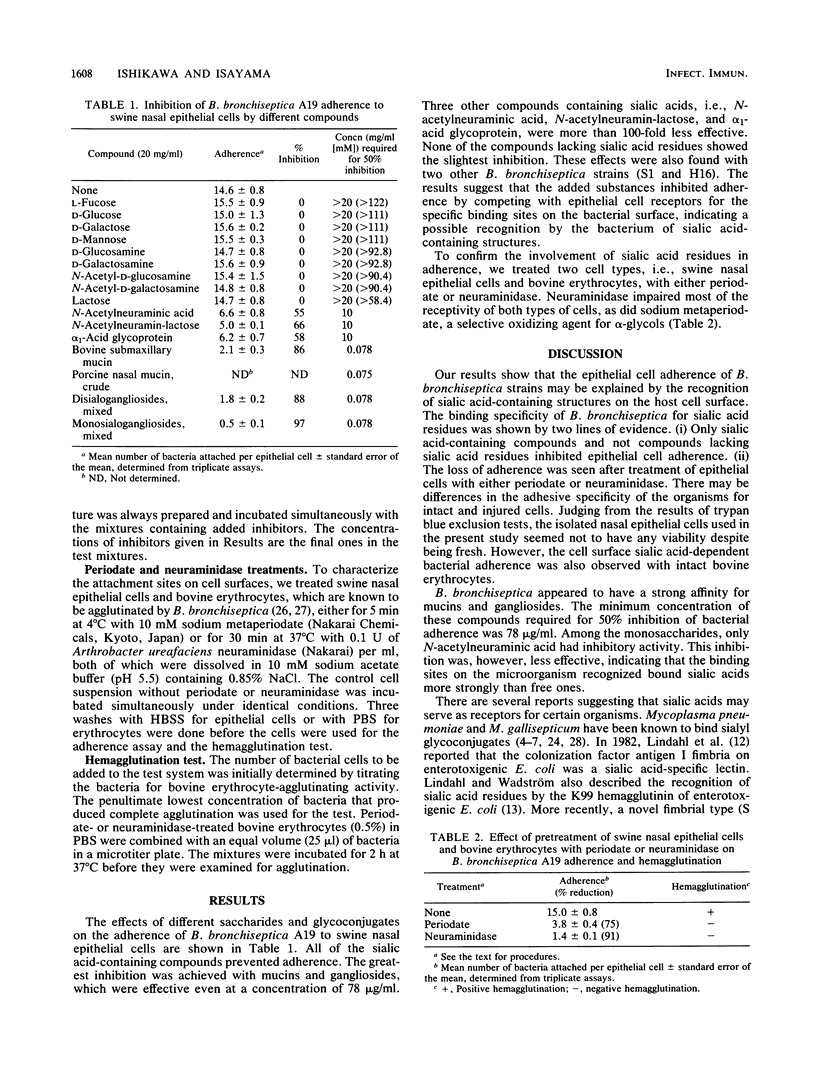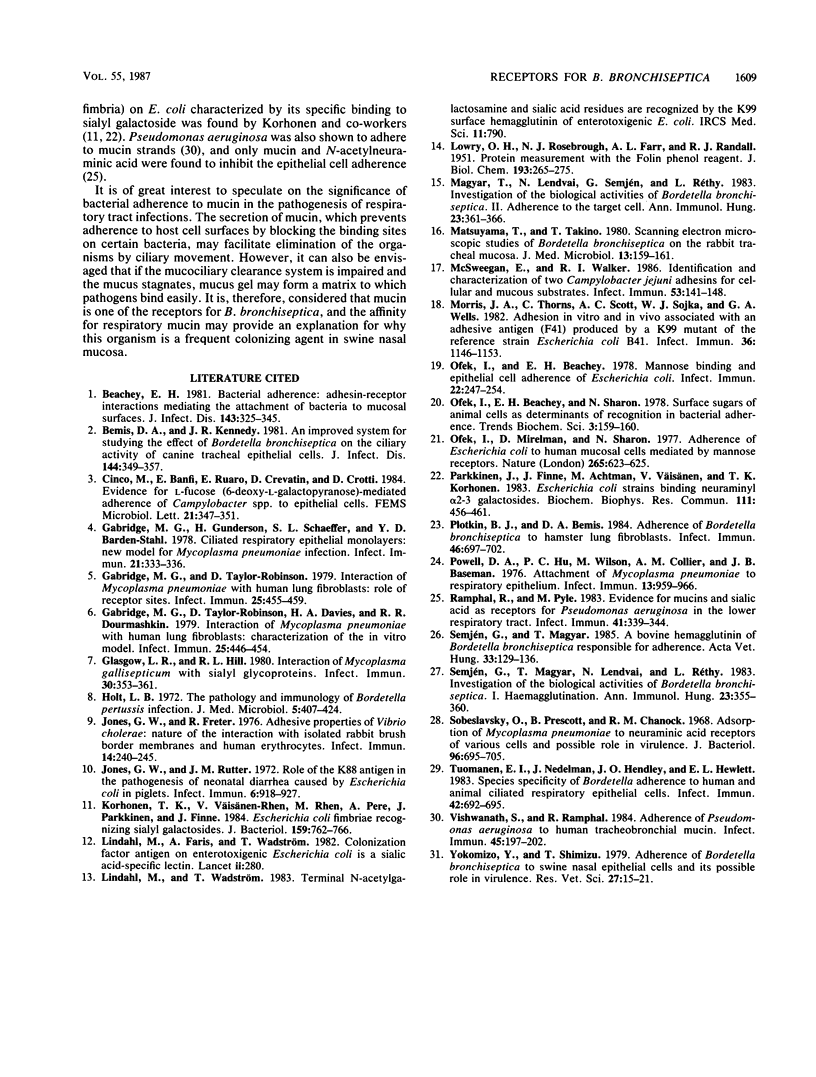Abstract
The nature of the receptors for Bordetella bronchiseptica was investigated by using the in vitro adherence assay system. The results indicated that sialyl glycoconjugates acted as receptors on swine nasal mucosa. These results were obtained by two independent approaches: inhibition of epithelial cell adherence with sialic acid-containing compounds but not with compounds lacking sialic acid residues and loss of adherence after treatment of epithelial cells with periodate or neuraminidase. B. bronchiseptica seems to have strong affinity for mucin. This may help the bacterium to colonize the mucosal surfaces of the swine nasal cavity.
Full text
PDF


Selected References
These references are in PubMed. This may not be the complete list of references from this article.
- Beachey E. H. Bacterial adherence: adhesin-receptor interactions mediating the attachment of bacteria to mucosal surface. J Infect Dis. 1981 Mar;143(3):325–345. doi: 10.1093/infdis/143.3.325. [DOI] [PubMed] [Google Scholar]
- Bemis D. A., Kennedy J. R. An improved system for studying the effect of Bordetella bronchiseptica on the ciliary activity of canine tracheal epithelial cells. J Infect Dis. 1981 Oct;144(4):349–357. doi: 10.1093/infdis/144.4.349. [DOI] [PubMed] [Google Scholar]
- Gabridge M. G., Gunderson H., Schaeffer S. L., Barden-Stahl Y. D. Ciliated respiratory epithelial monolayers: new model for Mycoplasma pneumoniae infection. Infect Immun. 1978 Jul;21(1):333–336. doi: 10.1128/iai.21.1.333-336.1978. [DOI] [PMC free article] [PubMed] [Google Scholar]
- Gabridge M. G., Taylor-Robinson D., Davies H. A., Dourmashkin R. R. Interaction of Mycoplasma pneumoniae with human lung fibroblasts: characterization of the in vitro model. Infect Immun. 1979 Jul;25(1):446–454. doi: 10.1128/iai.25.1.446-454.1979. [DOI] [PMC free article] [PubMed] [Google Scholar]
- Gabridge M. G., Taylor-Robinson D. Interaction of Mycoplasma pneumoniae with human lung fibroblasts: role of receptor sites. Infect Immun. 1979 Jul;25(1):455–459. doi: 10.1128/iai.25.1.455-459.1979. [DOI] [PMC free article] [PubMed] [Google Scholar]
- Glasgow L. R., Hill R. L. Interaction of Mycoplasma gallisepticum with sialyl glycoproteins. Infect Immun. 1980 Nov;30(2):353–361. doi: 10.1128/iai.30.2.353-361.1980. [DOI] [PMC free article] [PubMed] [Google Scholar]
- Holt L. B. The pathology and immunology of Bordetella pertussis infection. J Med Microbiol. 1972 Nov;5(4):407–424. doi: 10.1099/00222615-5-4-407. [DOI] [PubMed] [Google Scholar]
- Jones G. W., Freter R. Adhesive properties of Vibrio cholerae: nature of the interaction with isolated rabbit brush border membranes and human erythrocytes. Infect Immun. 1976 Jul;14(1):240–245. doi: 10.1128/iai.14.1.240-245.1976. [DOI] [PMC free article] [PubMed] [Google Scholar]
- Jones G. W., Rutter J. M. Role of the K88 antigen in the pathogenesis of neonatal diarrhea caused by Escherichia coli in piglets. Infect Immun. 1972 Dec;6(6):918–927. doi: 10.1128/iai.6.6.918-927.1972. [DOI] [PMC free article] [PubMed] [Google Scholar]
- Korhonen T. K., Väisänen-Rhen V., Rhen M., Pere A., Parkkinen J., Finne J. Escherichia coli fimbriae recognizing sialyl galactosides. J Bacteriol. 1984 Aug;159(2):762–766. doi: 10.1128/jb.159.2.762-766.1984. [DOI] [PMC free article] [PubMed] [Google Scholar]
- LOWRY O. H., ROSEBROUGH N. J., FARR A. L., RANDALL R. J. Protein measurement with the Folin phenol reagent. J Biol Chem. 1951 Nov;193(1):265–275. [PubMed] [Google Scholar]
- Lindahl M., Faris A., Wadstrom T. Colonization factor antigen on enterotoxigenic Escherichia coli is a sialic-specific lectin. Lancet. 1982 Jul 31;2(8292):280–280. doi: 10.1016/s0140-6736(82)90368-3. [DOI] [PubMed] [Google Scholar]
- Matsuyama T., Takino T. Scanning electronmicroscopic studies of Bordetella bronchiseptica on the rabbit tracheal mucosa. J Med Microbiol. 1980 Feb;13(1):159–161. doi: 10.1099/00222615-13-1-159. [DOI] [PubMed] [Google Scholar]
- McSweegan E., Walker R. I. Identification and characterization of two Campylobacter jejuni adhesins for cellular and mucous substrates. Infect Immun. 1986 Jul;53(1):141–148. doi: 10.1128/iai.53.1.141-148.1986. [DOI] [PMC free article] [PubMed] [Google Scholar]
- Morris J. A., Thorns C., Scott A. C., Sojka W. J., Wells G. A. Adhesion in vitro and in vivo associated with an adhesive antigen (F41) produced by a K99 mutant of the reference strain Escherichia coli B41. Infect Immun. 1982 Jun;36(3):1146–1153. doi: 10.1128/iai.36.3.1146-1153.1982. [DOI] [PMC free article] [PubMed] [Google Scholar]
- Ofek I., Beachey E. H. Mannose binding and epithelial cell adherence of Escherichia coli. Infect Immun. 1978 Oct;22(1):247–254. doi: 10.1128/iai.22.1.247-254.1978. [DOI] [PMC free article] [PubMed] [Google Scholar]
- Ofek I., Mirelman D., Sharon N. Adherence of Escherichia coli to human mucosal cells mediated by mannose receptors. Nature. 1977 Feb 17;265(5595):623–625. doi: 10.1038/265623a0. [DOI] [PubMed] [Google Scholar]
- Parkkinen J., Finne J., Achtman M., Väisänen V., Korhonen T. K. Escherichia coli strains binding neuraminyl alpha 2-3 galactosides. Biochem Biophys Res Commun. 1983 Mar 16;111(2):456–461. doi: 10.1016/0006-291x(83)90328-5. [DOI] [PubMed] [Google Scholar]
- Plotkin B. J., Bemis D. A. Adherence of Bordetella bronchiseptica to hamster lung fibroblasts. Infect Immun. 1984 Dec;46(3):697–702. doi: 10.1128/iai.46.3.697-702.1984. [DOI] [PMC free article] [PubMed] [Google Scholar]
- Powell D. A., Hu P. C., Wilson M., Collier A. M., Baseman J. B. Attachment of Mycoplasma pneumoniae to respiratory epithelium. Infect Immun. 1976 Mar;13(3):959–966. doi: 10.1128/iai.13.3.959-966.1976. [DOI] [PMC free article] [PubMed] [Google Scholar]
- Ramphal R., Pyle M. Evidence for mucins and sialic acid as receptors for Pseudomonas aeruginosa in the lower respiratory tract. Infect Immun. 1983 Jul;41(1):339–344. doi: 10.1128/iai.41.1.339-344.1983. [DOI] [PMC free article] [PubMed] [Google Scholar]
- Semjén G., Magyar T. A bovine haemagglutinin of Bordetella bronchiseptica responsible for adherence. Acta Vet Hung. 1985;33(3-4):129–136. [PubMed] [Google Scholar]
- Sobeslavsky O., Prescott B., Chanock R. M. Adsorption of Mycoplasma pneumoniae to neuraminic acid receptors of various cells and possible role in virulence. J Bacteriol. 1968 Sep;96(3):695–705. doi: 10.1128/jb.96.3.695-705.1968. [DOI] [PMC free article] [PubMed] [Google Scholar]
- Tuomanen E. I., Nedelman J., Hendley J. O., Hewlett E. L. Species specificity of Bordetella adherence to human and animal ciliated respiratory epithelial cells. Infect Immun. 1983 Nov;42(2):692–695. doi: 10.1128/iai.42.2.692-695.1983. [DOI] [PMC free article] [PubMed] [Google Scholar]
- Vishwanath S., Ramphal R. Adherence of Pseudomonas aeruginosa to human tracheobronchial mucin. Infect Immun. 1984 Jul;45(1):197–202. doi: 10.1128/iai.45.1.197-202.1984. [DOI] [PMC free article] [PubMed] [Google Scholar]
- Yokomizo Y., Shimizu T. Adherence of Bordetella bronchiseptica to swine nasal epithelial cells and its possible role in virulence. Res Vet Sci. 1979 Jul;27(1):15–21. [PubMed] [Google Scholar]


